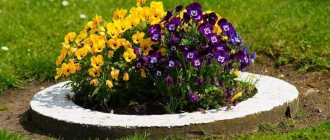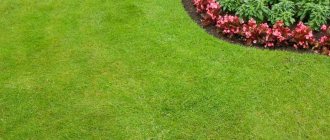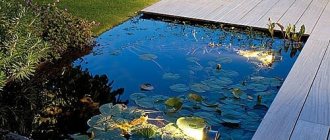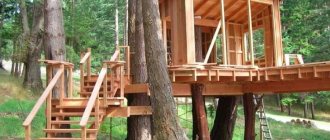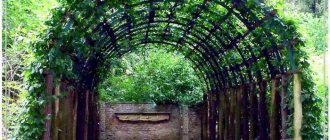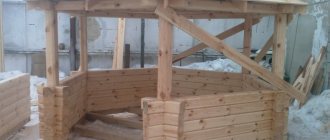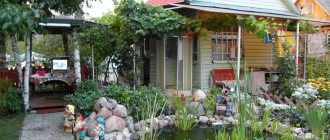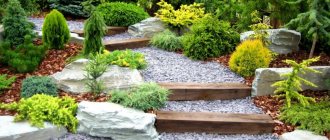Ordinary flower beds quickly fade, so they are pleasing to the eye for no more than two months a year. For owners who want to admire colorful carpets all season long, continuous flowering beds were invented, in which plants bloom at different times.
We'll tell you how to make a similar flower garden on your site, and what you need for this. Here are examples of the most popular flower beds that can be laid out on a plot of more than 6 acres.
Benefits of perennials
A garden flower bed made from perennials is a simpler solution than a flower garden made from annual plants.
The advantages of perennial flowers include:
- Unpretentiousness of most plants;
- The ability to avoid wasting time on growing seedlings and annual planting;
- Large selection of a wide variety of plants.
Perennial flowers can bloom all summer or give way to neighbors, adding variety to any flower bed. But even after flowering, perennials will continue to delight their owners with green foliage throughout the season.
Perennial flowers for flower beds, for the most part, are easily propagated by cuttings and rhizomes, and therefore do not require large financial costs for their propagation. And neighbors will be happy to share such flowers.
Perennials will easily tolerate the proximity of annual plants, so even a familiar flower bed can be decorated completely differently every year.
Useful tips
Iris dwarf
- It happens when plants start to get sick or are damaged by insects. They must be removed from the common flower bed. A gap appears that needs to be decorated with something. Experienced flower growers advise always having flowers in pots on hand, for example, zonal pelargonium - a very unpretentious flower, the cuttings of which can easily take root regardless of the time of year. Also, when the shoots are pruned, they are never thrown away. They are immediately planted in plastic cups with a large hole in the bottom and placed somewhere on the site. This won’t cause much trouble, but it will be very useful if you need to close a void that has formed somewhere.
- It is useful to repeat successful combinations of shades. Beautiful white hellebore flowers are very harmonious against a bright blue background of crocuses. For example, you can plant white anemones with hellebores, and dwarf irises in the same color scheme with crocuses. The flowerbed will look great throughout the spring season with large white flowers dominating the blue background of small flowers.
- Plants with variegated foliage are very successful when used as a frame for a flower bed or planted in groups. Coleus, for example, are very attractive with their velvety leaves with brightly varied colors and jagged edges. They are very unpretentious in cultivation and reproduction. In sunlight, the flower becomes even brighter, but it must be protected from direct sunlight. He is not inferior to his brothers in beauty. But its cost is much lower
Coleus in the flowerbed
You can create a unique, colorful creation with your own hands, even if you are a beginner. You just need to study a little information, follow the basic rules, and listen to the advice of professionals. You don't have to take on something heavy right away. Mastery comes with experience. All you need is desire. And don't be afraid to make mistakes.
Rules for creating a flower bed of perennials
Beautiful perennial beds will require careful planning. You can start this process at any time in winter and autumn, without wasting precious hours during the period of planting the main inhabitants of the garden.
You should pay attention to such indicators as:
- Illumination. Most perennials love bright sunlight, but there are plants that prefer light partial shade or completely shaded areas (hostas, ferns, lilies of the valley). They will be extremely uncomfortable in one territory.
- Humidity. Typically, perennials prefer moderate watering, but roses will require much more moisture than mosses, lupins, and phlox.
- The soil. Of course, all plants, without exception, will like black soil, but most perennial plantings (irises, daisies, asters, Turkish carnations) can easily grow on poor soils.
- A color scheme. A flowerbed of continuous flowering should be arranged in such a way that their opened buds gracefully complement each other. Monoflowers that combine shades of the same color can boast of particular beauty. Contrasting elements should not exceed a fifth of the flower bed. The prettiest backgrounds are considered to be white, soft pink, and blue shades. Smooth and glossy green leaves will beautifully reflect sunlight, giving the flowerbed more shine, and matte leaves will softly absorb the natural rays of the sun, creating a calm and serene mood.
Interesting fact: City dwellers prefer to use soft colors, while residents of private houses prefer brighter colors.
tall plants
Interesting options with a height of up to 80 cm are:
- Gladioli;
- Geranium;
- Astilbe;
- Delphinium;
- Daisies.
The choice depends on the level of illumination of the area. Chamomiles prefer an abundance of light, Delphinium and Geranium are unpretentious, and Gladioli and Astilbe love shade. Optimal specimens are determined individually.
Recommendations
When creating a flower bed, special attention is paid to:
- The unity of the flower garden and the surrounding landscape. You should not make flower beds that are too elaborate in the middle of the beds or next to a one-story wooden house or shed. But modern, respectable houses made of glass and concrete will not be very happy to be next to a “shaggy” flower bed. For rural designs, the most suitable element would be a flower bed containing herbs.
- Simplicity. In nature, you want to take a break from complex shapes, overly saturated colors, and an abundance of decor, so it is better to create a cozy and eye-pleasing flower bed or place several flower beds than to create a complex composition.
What is a discount?
The word rabatka comes from the German rabatte, the original meanings of which are lapel, lapel, border, cuff, and these meanings give a good idea of the “garden” meaning of the word: an elongated flower bed, usually located along some area of the site.
Work along the path
There are discounts:
- spring, summer, summer-autumn
- single color or solid
- decorative foliage (formed from tall plants) or carpet (the composition is made from low-growing plants)
- one-sided and two-sided
- rectilinear and arched.
Arc-shaped ridge
Warning
Perennial plants grow greatly over time, so there should be more space between them. At first, the bald spots in the ground will be covered with annuals or ground cover plants.
Landscape Design Rules
The main area of the dacha is occupied by healthy fruit and berry plantings, vegetables and herbs. Naturally, there is very little space left for a flower garden.
As a rule, these are spaces along fences and near a country house. To fill this void, you need to know the principles of flower bed design.
Before deciding what to plant, you need to answer the following questions:
how much area is planned to be devoted to a flower garden. If the flower bed near the fence is long and large, then the choice of plants is practically unlimited. If there is very little space in the dacha, then the flowers should be miniature and not “aggressive”.
When planting, it is important to plant plants with the same requirements for watering, soil, and light. To do this, you need to find out which side the fence is on (sunny or shady), what crops the dacha owner plans to plant (whether they require care or not).
Flower garden along the fence Source pinterest.com
Near what kind of fence will there be a flower garden: solid or sparse (made of wooden slats, chain-link mesh, metal profile). What is the height of the fence, how hot does it get, whether it is necessary to hide the fence with plantings or leave it open.
When planting plants on the south side of the site, choose drought-resistant crops that need a lot of light. The soil in this part of the dacha will need to be constantly watered, so it is not recommended to plant delicate plants here that require abundant watering: crocuses, tulips. For a flower bed along the southern part of the fence, planting thyme, iris, and mallow is perfect.
On the northern side of the site, plants that can withstand strong winds and are cold-resistant are planted. For a flower bed near a fence, hosta plantings, stone compositions with coniferous shrubs, horizontal juniper, and ferns are well suited. In addition to low-growing plants, tall thujas can be planted on the side of the fence.
Most often, a flower bed is made with smooth borders and curves, as in this photo Source samozvetik.ru
Rigid rectangular flower beds can be arranged in the form of small compositions of flowers of different colors, but of the same type. For example, marigolds, petunias.
Flower arrangement Source pinterest.com.mx
Types of flower beds
As photos of flower beds of perennials show, gardeners are most fond of simple flower beds in the form of circles, squares, diamonds, and borders.
But with little labor, you can make more unusual flower beds:
- Neat discounts;
- Luxurious mixborders;
- Unusual arabesques;
- Original rockeries and alpine slides.
Cute ring flower beds can help draw attention to a specific feature. Such flower beds are located around interesting bushes, trees, and garden sculptures.
A modular flower bed is a fairly large landscape object. It is divided into separate fragments by paths, tiles, and bricks. But all such areas must be harmoniously combined with each other.
A carpet bed of perennial plantings often replaces a boring lawn. It is made up of ground cover plants that imitate a fluffy rug.
- Multidimensional flower beds of perennials (in pots, boxes, baskets) are used much less frequently than similar works of garden art made of annuals.
- This is due, first of all, to the fact that the roots of plants left to overwinter in a small container may freeze during the cold period.
- Most often, when using such options for placing flowers for the winter, they are moved to a more or less warm room.
- Do the same with vertical flower beds.
Option 5. Flower garden at the entrance to the site
The flowerbed at the entrance to the garden area should be the brightest and most impressive. Here is an example of such a flower garden:
The year-round whitish-blue needles of the dwarf spruce Glauka Globoza will not leave anyone indifferent. In contrast to it, it is worth planting green horizontal juniper. The spring season in the flower garden opens with Spiraea Nippon Snowmund, followed by cinquefoil, Japanese spirea, spurge, Douglas spirea and tree hydrangea. Heuchera also brings a certain color to the flower garden - all thanks to its bright red foliage.
Disembarkation rules
Any scheme for a flower bed of perennials involves planting plants in such a way that all inhabitants of the flower garden have enough sun. Therefore, tall plants are relegated to the background, medium-sized plantings are located in front of them, and space in front is reserved for very small representatives of the kingdom of Flora.
The exception is circular flower beds: in them, tall plants are located in the center of the composition.
Mixborder scheme
Plant tall plants up to 1.5 meters in height closest to the fence. These are rudbeckia, asteraceae, foxgloves and other perennials with large flowers and leaves.
When selecting flower arrangements, designers usually arrange two or three crops of different flowering periods together so that the fence does not look bare.
Secondly, medium-sized plants are planted. This row creates the splendor of the entire composition, so plants are chosen for it that, even after flowering, do not lose their attractiveness.
These can be pinesettum, chrysanthemums, lavender Source sewerge.ru
Lastly, form the border of the flower bed. Ground cover plants are best suited for this. For example, spirea, nasturtium, cornflowers.
An example of a mixborder scheme Source krapivada.ru
Simple and complex flower beds
Depending on the type of plant, flower beds are divided into regular and irregular flower beds.
In the first case, flowers are planted in strict accordance with the invented scheme, and all plants must bloom at the same time. Such a flowerbed requires quite a lot of work.
An irregular flower bed is simpler to design and does not require rigid attachment to the design. There are no mandatory requirements for pattern, color scheme, or flowering period. Such flower beds do not require additional care and can bloom all season long if you choose the right plants.
And today there are a great variety of plants ready to decorate plots of land for many years. So there is always the opportunity to choose the most unpretentious and attractive inhabitants of the flowerbed. And experienced flower growers will be able to choose more capricious creatures.
Proper Neighborhood Observance
When combining different plants at close range, it is necessary to take into account the characteristics of the specimens, which can have both positive and negative aspects. The following types of “hostility” are known:
- roses with carnations, mignonette;
- lilies with tulips;
- lilies of the valley with peonies and violets.
Despite the negative interaction, some flowers are able to “help” their neighbors. Marigolds, nasturtium, petunia, and phlox have these features.
Photos of perennial flower beds
↑ Caring for flowers along the fence
It is not difficult to care for a continuously blooming flower bed along the fence. Maintenance is standard: regular watering, scheduled fertilizing, loosening the soil and removing weeds. Part of the shoots of overgrown flowers is removed during sanitary pruning of plants. Inflorescences that have bloomed and yellowed leaves are cut off. Perennial flowers should not be allowed to form seeds. So perennials will spend their energy on the growth of new basal leaves or on the formation of new shoots with buds.
Carefully cut off the flowering shoots of peonies and lilies - not to the soil level. In these flowers, nutrients flow from the shoots and leaves directly into the bulb and rhizome. The result is the following picture: the tops are aging, and the roots are maturing. By planting tall geranium, astilbe or mantle near the lilies, the wilted shoots of the lily are hidden.
Annual flowers begin to die with the arrival of autumn. These places are cleared of plant remains and dug up. In place of annuals, you can plant bulbous crops in the fall.
Shrubs
Shrubs can be used as an independent hedge, or you can decorate an existing fence with them. Use varieties of the same size but different colors. Don't forget about shaping the crowns so that your fence is always beautiful and tidy.
Derain
This is the most popular shrub for planting along fences because it is easy to trim and holds its shape well. Derain has an unusual silvery color, and it also gets along with other varieties without any problems. Such a fence reliably protects from dust if there is a road on the other side. And the turf grows quickly and literally grows by a whole meter in just six months.
Photo: mykaleidoscope.ru
Barberry Thunberg
The main advantage of this type is its wonderful appearance. Globular bushes with large matte leaves grow up to 90 cm. In autumn they acquire a delightful red-yellow hue and do not fly around for a long time. But remember that Thunberg barberry does not like drafts, cold wind and shade.
Photo: pokrovdvor64.ru
Hydrangea
For landscaping along a fence, paniculate hydrangea with large lush inflorescences is best suited. It grows as a large loose bush up to 2-3 meters, and can be given any shape. The tree-like hydrangea with its dense greenish balls-inflorescences is also good.
Photo: flo.discus-club.ru
Chubushnik
It is not for nothing that mock orange is called the double of jasmine, but at the same time it is much less capricious and more resistant to our latitudes. The perennial ornamental shrub tolerates harsh winters well, and with the beginning of flowering it delights with a delicate jasmine aroma and snow-white inflorescences. In compositions along the fence, mock orange goes well with hydrangea, because it belongs to the same family.
Photo: prorastet.ru
Spirea
Spiraea is a beautiful ornamental shrub with bright large leaves and unusual pubescent inflorescences. It is absolutely unpretentious, it does not need to be constantly fertilized and watered, and it coexists well with other plants. Spiraea bushes can be shaped or left as is - they grow beautifully without pruning.
Photo: pinterest.ru
Lilac
Lilac is valued for its beauty, aroma and variety of shades - it will become a real decoration of the area along the fence. Amur lilac is considered the most frost-resistant, while the rest are more demanding of heat. All species require good lighting, low groundwater levels and regular care.
Photo: da4nik.ru
Elder
In our latitudes, elderberry is often found on the side of paths and country roads. This means that it is also great for landscaping areas along the fence. Black elderberry has dozens of ornamental varieties with multi-colored leaves and increased productivity. The bushes are very moisture-loving, but at the same time very hardy.
Photo: goldvoice.club
Currant
Currant bushes are quite difficult to take root, but then they delight you with their beauty, aroma and useful harvest. They are planted at a distance of about half a meter and formative pruning is carried out in the spring. Currants love the sun, loosening the soil and root watering. After 15 years, the bushes will have to be renewed.
Photo: akaoray.ru
Blackberry
If you want to plant berry bushes along the fence, but don’t have time for constant care, choose blackberries (or raspberries). She is very unpretentious and will delight you with a rich harvest every year. Just keep in mind that both species reproduce quickly and fill the entire area. Keep an eye on this and don't let the branches touch the ground.
Photo: m.fotostrana.ru
Boxwood
The most popular evergreen shrub for creating garden sculptures is boxwood. It is used by landscape designers around the world as a main element and as a complement to the composition. Boxwood grows slowly: on the one hand, at first you will have to be patient, and on the other hand, later you will not need to thin out and shorten the crowns every season.
Photo: selsov.ru
Flowers similar to lilies: names and photos (catalog)
↑ Shrub fence
An alternative to standard fencing and an incredibly effective one would be to create a bush fence at your dacha. It turns out that there are two in one: a flowerbed and a fence. When planting a living fence of shrubs, first determine its purpose.
- Aesthetic function. Flowering shrubs will create a chic appearance for the fence: jasmine, lilac, barberry, viburnum, spirea, hydrangea and others. The flowering time of shrub crops varies: from mid-spring to mid-summer. If you create compositions from different types of plants, you can form a continuously flowering hedge.
- Advice! It is better to select shrubs with the same type of leaves and the same height, but with different flowering periods. Lush and tall bushes do a good job of protecting.
- Function: impenetrable and thorny fence. To make penetration into the area as difficult as possible, thorny bushes are used: tea rose, rose hip, blackthorn, gooseberry, hawthorn.
- Function – the fence is evergreen and living. A fence made of evergreen shrubs can decorate and at the same time protect a site at any time of the year. Evergreen crops include: heather, thuja, erica, juniper.
↑ Height of bush fence
- Low fence. To create a low hedge (up to 50-60 cm), shrubs are planted: gooseberries, boxwood, artisanal cinquefoil, alpine currant, yellow acacia.
- Living fence up to three meters. Shrubs suitable for hedges are: lilac, thuja, rose hips, hornbeam, juniper.
- A fence made of tall (from three meters) bushes. A high fence will be obtained by planting the following shrubs: hawthorn, yew, dogwood, western thuja, and common hornbeam.
When planting plants, consider:
- compatibility with other shrubs;
- flowering time;
- unpretentiousness when growing;
- ease of pruning and crown formation;
- growth rate.
A well-maintained living fence at the dacha will be the hallmark of the site. Caring for a bush fence involves fertilizing the plants, trimming and watering. Seedlings for planting are chosen especially carefully, since all the bushes must grow together, creating the integrity and beauty of the fence.
It is important to trim the bushes regularly, this will keep the fence in excellent condition. Even when the crown grows freely, this does not mean that the plants do not require pruning. Regular pruning will make the bushes denser, the bushes will bloom more abundantly and luxuriantly, which is important for a living fence.
↑ Planting along a metal fence
Fences made of corrugated sheets are the most common option today as a material fencing an area. A corrugated fence is durable and has a long service life. The disadvantage of such a fence is that there is little shade and in the summer the metal gets very hot.
As a solution to the problem: metal sheets alternate with mesh. And now it’s not a problem to find shade-tolerant specimens. What is planted along metal fences:
- raspberries, tall currants, blackberries, honeysuckle (all tall varieties of shrubs are tied up);
- unpretentious viburnum, which will generously provide a harvest of berries;
- junipers, but only shade-tolerant species that are not afraid of darkening.
A good option is alternating shrubs, low-growing trees and low flowers. Shrubs and flowers are placed in the foreground, and trees are planted directly along the fence. The created compositions look very impressive and perfectly complement a nearby gazebo or gazebo.
In hot summers, a profile fence gets hot, sometimes very hot. To prevent burns from appearing on the leaves and petals, they are placed at some distance from the fence. Along a continuous fence you can use one of the following types of crops: hosta, hydrangea, decorative allium, etc.
Stones and bricks are used as a decorative border for a flower garden near a corrugated fence.
↑ Forged metal fence
Wrought iron fences are generally rare, but these types of fences provide excellent visibility. And flowering plants are chosen in such a way that the flowerbed blooms all season. Then the perimeter near the fence will look beautiful and impressive.
A forged fence looks elegant, decorated with bright inflorescences in hanging containers.
When the flower bed is wide, the plants are planted in tiers: the further the distance from the fence, the lower the tier. Suitable exhibits are boxwood, juniper, low-growing thuja, heuchera, saxifrage, and primrose. And to create an elevated decorative border, bricks or stones are used inside the site.
If the flowerbed is narrow but long, it is better to plant plants of the same type: asters, carnations, lavender, etc.
